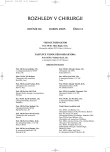Options for Combining Surgical and Endovascular Techniques in the Management of Large Aneurysms and Dissections of the Thoracic Aorta
Možnosti použití kombinace chirurgických a endovaskulárních technik v léčbě rozsáhlých aneuryzmat a disekcí hrudní aorty
Chirurgická léčba aneuryzmat a disekcí hrudní aorty stejně jako jejich endovaskulární léčba má své technické i medicínské limity. Cílem této práce je poukázat na možnosti kombinací obou léčebných metod a podělit se o první praktické zkušenosti z jejich provádění, přičemž prováděné výkony dělíme do následujících skupin:
– kombinované výkony, kdy chirurgická část umožňuje implantaci stentgraftu do descendentní aorty nebo řeší technicky nedokonalý efekt této implantace,
– výkony, kdy kombinací chirurgické a endovaskulární léčby podstatně snížíme operační zátěž především odstraněním nutnosti použití mimotělního oběhu a oběhové zástavy,
– výkony, při kterých kombinujeme výhody chirurgické léčby v oblasti aortálního oblouku a endovaskulární léčby v oblasti descendentní aorty.
Použití kombinace chirurgických a endovaskulárních technik v léčbě rozsáhlých aneuryzmat či disekcí hrudní aorty se jeví jako perspektivní metoda. Nemocnému může přinést nižší perioperační riziko a nižší pooperační morbiditu. Lze předpokládat dobrý dlouhodobý efekt této léčby, který však bude třeba verifikovat dlouhodobým sledováním nemocných.
Klíčová slova:
aneuryzma hrudní aorty – disekce – endovaskulární léčba – hybridní výkon
Authors:
R. Brát; B. Dočekal; R. Jursa
Authors‘ workplace:
Kardiochirurgické centrum FNsP Ostrava, primář MUDr. R. Brát, Ph. D.
Published in:
Rozhl. Chir., 2005, roč. 84, č. 4, s. 201-205.
Category:
Monothematic special - Original
Overview
The surgical management of aneurysms and dissections of the thoracic aorta, as well as their endovascular management, all have their technical and medical limits. The aim of this work is to point out possibility for combination of the both treatment methods and to share our first practical experience with this procedure. The procedures conducted have been divided into the following groups:
– combined procedures, where the surgical part enables implantation of the stentgraft into the descending aorta or is managing imperfect results of such implantations,
– procedures, where combining the surgical and endovascular treatment lowers operational stress of the patient, as the extracorporeal circulation and the circulation arrest are not required,
– procedures, where advantages of both the surgical treatment in the region of the aortic arch and the endovascular treatment in the region of the descending aorta, are combined.
Using the combination of both the surgical and endovascular techniques in the management of the large aneurysms and dissections of the thoracic aorta, appears to be a perspective method. The patient may benefit from its lower perioperative risk rates and lower postoperative morbidity rates. A good long-term effect of the above treatment method may be expected, however, it has to be verified in long-term patient studies.
Key words:
aneurysms of the thoracic aorta – dissection – endovascular treatment – hybrid procedure
Labels
Surgery Orthopaedics Trauma surgeryArticle was published in
Perspectives in Surgery

2005 Issue 4
- Metamizole vs. Tramadol in Postoperative Analgesia
- Current Insights into the Antispasmodic and Analgesic Effects of Metamizole on the Gastrointestinal Tract
- Spasmolytic Effect of Metamizole
- Metamizole at a Glance and in Practice – Effective Non-Opioid Analgesic for All Ages
Most read in this issue
- Carcinoids of the Appendix
- Prevention, Diagnosis and Treatment of Iatrogennic Lesions of Biliary Tract during Laparoscopic Cholecystectomy. Managament of Papila Injury after Invasive Endoscopy. Part 1.
- Cooperation between a Surgeon and a Gastroenterologist in the Management of Vascular Complications of the Liver Cirrhosis
- Surgical Therapy of Iatrogenic Injury of Biliary Tract after Cholecystectomy and Invasive Endoscopy. Part 2.
